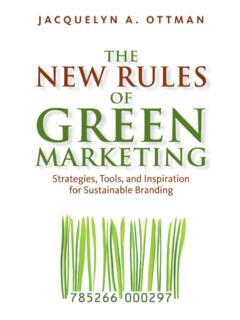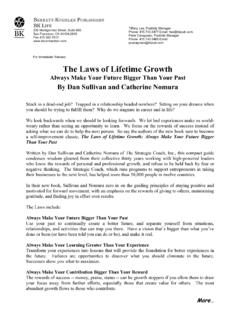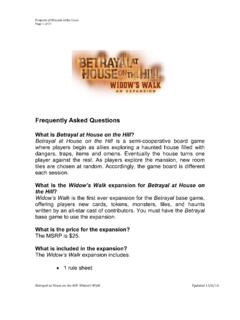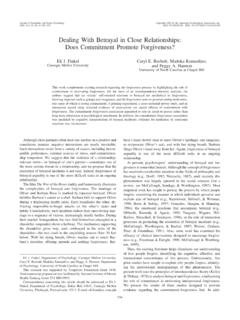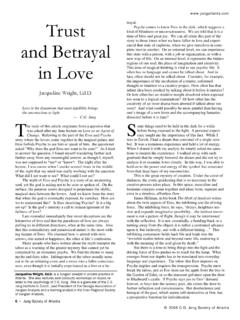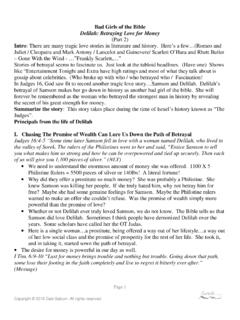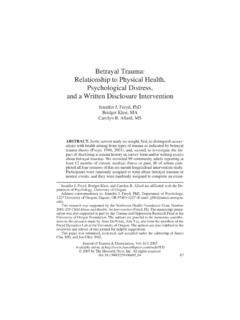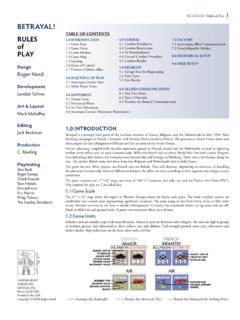Transcription of Trust and Betrayal in the Workplace Building Effective ...
1 An excerpt from Trust and Betrayal in the Workplace Building Effective Relationships in Your Organization 2nd Edition by Dennis Reina and Michelle Reina published by Berrett-Koehler Publishers Jamie was the vice president of global leadership developmentfor a Fortune 50 corporation. She was charged with overseeingthe implementation of the company s new performance managementsystem, overhauling their approach to change management, and devel-oping and rolling out a leadership development training program,among a host of other initiatives.
2 This all had to be executed throughoutthe company, worldwide, in record time to support aggressive had a 150-person global unit of highly committed, talentedpeople with heart, soul, and deep pride for the work they do. After all,they were the unit that facilitated initiatives throughout the companythat made a difference in people s lives. However, the unit was payingthe price of three restructurings in two years, the loss of 35 percent of its people, and significant budget cuts. Roles and responsibilities wereunclear, decision-making boundaries were blurred, and expectationswere not understood.
3 Anxiety was high. People no longer understood thedirection of the unit or the direction of the company; they did not know3 CHAPTER1 THENEED FORTRUSTIN THEWORKPLACE what the future held for them, and they did not have a place to go totalk about lack of clarity and alignment created confusion and distrac-tions. The Trust people once had in one another eroded, and relation-ships collapsed. Channels of communication and collaboration, alreadychallenged by having to accommodate people working all over theworld, gradually broke down.
4 People were at each other s throats, fight-ing for resources, hoarding information, and working at cross-purposeswith one another. The quality of the work declined, and the time line todelivery was drastically off course. The group s reputation within theorganization was this scenario sound familiar? In it do you see yourself or otherswith whom you have worked? Whether Jamie and her people realized itor not, high levels of Trust had previously enabled them to have highlyeffective relationships that made them successful.
5 Now, lower Trust under-mined relationships and compromised the unit s overall ability to like Jamie s happen all the time. When they arise, weoften feel helpless and hopeless, and hold the perception that there isnothing we can do. Yet we cando something about it! This book is abouttrust the power when it exists, the pain when it is betrayed, and thesteps you can take to rebuild it when it is rebuild Trust , Jamie and her people need to understand just howimportant Trust is to every aspect of their relationships with one need to learn the behaviors that build Trust and how practicing thosebehaviors contributes to their performance and the company s need to learn what breaks Trust and what they can do to rebuild andmaintain it.
6 Let us begin!THENEED FORTRUSTT oday more than ever there is the need for Trust a business need and ahuman need. The business landscape is constantly changing. Mergers andacquisitions; restructuring; strategic initiatives that require collaboration,employee engagement, risk taking, creativity, and innovation with shrink-4 WHYTRUSTing resources; and asking people to do more with less have become a wayof life in industries across the globe. To take their organizations to the nextlevel whether it be increased speed to market, enhanced patient care,greater customer satisfaction, improved cost containment, cutting-edgetechnology, reduced union grievances, or expanded community out-reach businesses need their employees to embrace and adapt to changeand to show up fully engaged and committed.
7 In short, businesses needpeople to work in relationship with one another to produce is conducted through relationships, and Trust is the founda-tion of Effective relationships. People need their relationships with cowork-ers to be trusting ones if they re to get their job done. They need to be ableto depend on each other to do his or her part, to believe that what cowork-ers are saying is the truth, to have confidence that they have what it takes todeliver, to receive honest feedback on the quality of their work and coach-ing from one another to learn new skills.
8 Trusting relationships are whatmake the difference between people s feeling good about what they do andsimply going through the motions. Trust is inspiring and energy today have a need for connection with their coworkers, andtrust makes that connection possible. People have a need to understandothers and to be understood in return; to use their skills, talents, and fullrange of capability; to challenge and be challenged; to share informationand receive information; and to count on others and be counted Trust is present, people are excited about what they do.
9 Theycollaborate freely, channels of communication open up, the sharing ofideas becomes the norm, and people are not afraid to make take pride in the organization they work for, are committed to thepeople they work with, and bring themselves more fully to their jobs. Intrusting environments, people are able to focus on their jobs; they aremore productive and want to come to good news is that leaders increasingly understand the need for realize that the cost of not having it is too great to be ignored. Yettrust is highly complex; it means different things to different people andis emotionally provocative.
10 It takes time to develop and can be broken inTHENEED FORTRUST IN THEWORKPLACE5an instant. The mere word truststirs something in all of us, either warmfeelings associated with positive experiences or sad or angry feelings asso-ciated with the loss of trustOften people assume that it is onlythe organizations with morale andperformance problems that engage in Trust Building . Although organiza-tions with problems do engage in Trust Building as a viable solution, it isnot onlyproblems that draw organizations to this effort.

